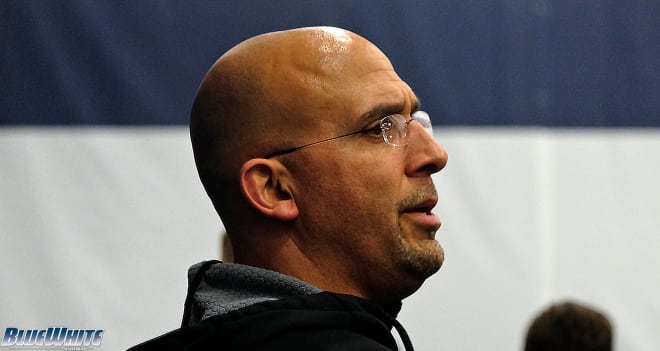Column: Armed with research, Franklin makes case for urgency
Subtlety is, in most instances, James Franklin’s chosen avenue of communication.
From his longstanding policy of not discussing player injuries, or his hesitance to wade into college football’s controversial topics without personal research to back up an opinion, Franklin has made the practice standard.
For three days last week as part of Penn State’s annual Coaches Caravan, Franklin bucked that norm as it relates to the past, present, and future of the Nittany Lion football program.
Armed with well-researched data comparing Penn State’s spending to that of its immediate peers, both within the context of the Big Ten’s powerhouse programs as well as on college football’s national stage, Franklin offered a bold assessment.
“I think we've done some pretty significant studies, and when it comes to football-specific spending on facilities and those types of things, we're way behind,” Franklin told reporters at the New York stop of the caravan. “We're probably 13 out of 14 in the Big Ten, which would probably surprise you. We're probably ahead of Rutgers and that's it when you talk about facilities over the last eight years.”

Having broken down the research into phases of three, five, and eight years, Franklin said the results proved significant work was necessary to catch up to the spending norms for salaries, facilities, and other areas.
According to publicly available Equity in Athletics Data Analysis documents, Penn State’s operating expenses for football during the 2016-17 fiscal year were $9,966,893, recruiting expenses were $1,946,649, and total expenses amounted to $39,163,720.
In comparison to Penn State’s direct competitors in the Big Ten East, the numbers put the Nittany Lions at first in operating expenses ahead of Ohio State ($9,661,535), Michigan ($6,521,230), and Michigan State ($5,737,978). In recruiting, the Nittany Lions were outspent only by Michigan ($2,365,266), while remaining ahead of Ohio State ($1,445,095) and Michigan State ($1,312,436). The pecking order aligned likewise for total expenses with Michigan ($46,249,632) leading the way, followed by the Nittany Lions, Buckeyes ($38,446,470), and Spartans ($26,326,106).
Asked about EADA numbers specific to men’s basketball at an April press conference with Patrick Chambers, however, director of athletics Sandy Barbour cautioned against reading too much into the figures against Big Ten or national peers. Given a lack of specificity within the reports, Barbour explained that her readings of the numbers are not necessarily in step when framed by a more thorough understanding of each program’s needs.
“We're constantly looking at that. I would caution all of us from an EADA or any kind of benchmarking standpoint that those are typically comparing apples to grapefruits sometimes. And I'm not sure who is grapefruits and who is oranges or apples,” she said. “But it's our job, and my job, to always take a look at what do we need. What do we need to compete? And those are the kinds of things we're examining every day. Because again, the goal is to compete in the Big Ten, be a factor in the Big Ten race and get to the NCAAs, and so, how are we going to resource that? What is that proper resource level? I'm not as worried about what's going on at other places because again, you don't really know what those numbers mean.”
Per Franklin, a second caveat is also important when trying to understand spending and Penn State’s place in it for both the Big Ten and nationally.
Namely, he said, the most recent numbers are less critical to the picture than those that preceded the uptick in the past couple of years. Describing a 10-year period in which the program wasn’t “really doing the things that we need to do year-in and year-out,” Franklin said that the problem is about playing catch-up to the progress that had been made by peers during that period of relative dormancy.
For instance, in comparing Penn State’s football expenses to those of Ohio State in the past 14 years of publicly available EADA documents, the numbers vary more widely. During the span dating back to 2003, the Buckeyes have collectively spent $426,980,707 on football. In the same timeframe, Penn State spent $326,212,398 on football, a difference of $100,768,309 total or $7,197,736 each year.
The Nittany Lions’ spending does, however, compare favorably to both Michigan and Michigan State in the same timeframe, leading the Wolverines ($313,808,620) and the Spartans ($284,553,852) in total expenses on football.
Questioned about Franklin’s comments specific to capital spending, ranked 13 of 14 programs in the Big Ten over his given timeframe of eight years, Barbour explained her ongoing approach to the situation moving forward.
“It just means we've gotta catch up,” she said. “We've been doing it over the course of the last four or five years and we probably need to accelerate that. So we've known it. That isn't any surprise, it just means we have a lot of work to do.”
Revealing a facilities master plan for all of athletics in March 2017, one that included a major proposed renovation to Beaver Stadium that would not begin construction for at minimum another five years, the fiscal concerns for Franklin extend beyond Penn State football’s physical structures.
Though the program has already implemented renovation improvements to the Lasch Building as well as Holuba Hall, with others ongoing, Franklin expressed his concern regarding spending on assistant coaches. In this, the beginning of his fifth year at Penn State, Franklin has already seen assistants Bob Shoop, Herb Hand, Josh Gattis and Charles Huff leave for jobs that wouldn’t necessarily be described as obvious advancement in their career trajectories.
“We’ve lost a number of assistants for lateral moves, and that can't happen,” said Franklin in Philadelphia, noting his satisfaction at Joe Moorhead’s hiring as head coach at Mississippi State this offseason. “Awesome. I want that for him, I want that for his family, and he's going to do a great job. But what we've gotta do is, we've gotta make sure that we're not losing assistants for lateral moves. If they're leaving to become coordinators, if they're leaving to become head coaches, then that's wonderful. But at a top ten program, like we are now, we shouldn't be losing (assistants) for lateral moves.”
In considering the impact of the program’s overall philosophy toward creating the most conducive environment to succeed, then, Franklin conveyed an urgency to the process. Riding a wave of momentum that has included back-to-back years of New Year’s Six bowl appearances and a Big Ten championship, the opportunity to make the strides necessary to again put the program on a completely level playing field with its national and elite conference peers is a window worth stepping through post-haste.
“We're trying to play catch-up for a 10 year period of time where we didn't really do a whole lot,” said Franklin. “But the hard part is, it's not like everybody else is pressing the pause button waiting for us to catch up. So as we're trying to catch up, they've got the foot on the gas driving forward. So we made tremendous progress in a short period of time, but we gotta go.
“And I knew we had to go, and we have kind of a process in stages of how we're going to work at it, but now after getting done this deep dive on research and seeing clearly where we are…we got some work to do.”
